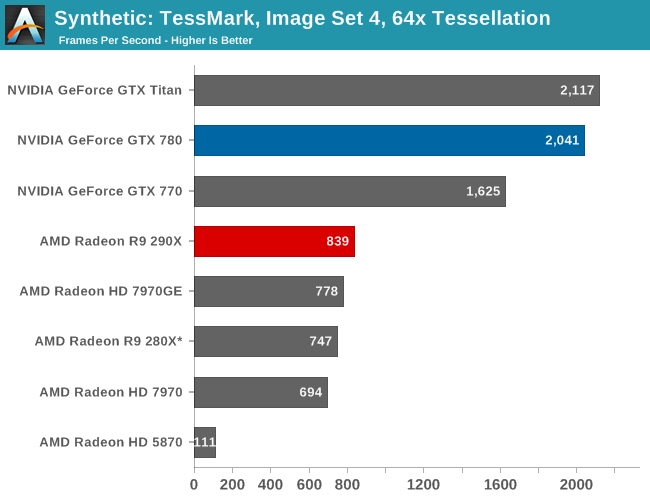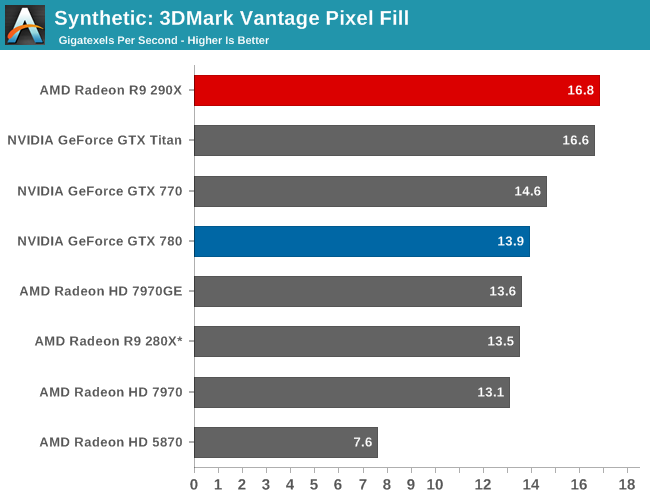The AMD Radeon R9 290X Review
by Ryan Smith on October 24, 2013 12:01 AM EST- Posted in
- GPUs
- AMD
- Radeon
- Hawaii
- Radeon 200
Synthetics
As always we’ll also take a quick look at synthetic performance. The 290X shouldn’t pack any great surprises here since it’s still GCN, and as such bound to the same general rules for efficiency, but we do have the additional geometry processors and additional ROPs to occupy our attention.

Right off the bat then, the TessMark results are something of a head scratcher. Whereas NVIDIA’s performance here has consistently scaled well with the number of SMXes, AMD’s seeing minimal scaling from those additional geometry processors on Hawaii/290X. Clearly Tessmark is striking another bottleneck on 290X beyond simple geometry throughput, though it’s not absolutely clear what that bottleneck is.
This is a tessellation-heavy benchmark as opposed to a simple massive geometry bencehmark, so we may be seeing a tessellation bottleneck rather than a geometry bottleneck, as tessellation requires its own set of heavy lifting to generate the necessary control points. The 12% performance gain is much closer to the 11% memory bandwidth gain than anything else, so it may be that the 280X and 290X are having to go off-chip to store tessellation data (we are after all using a rather extreme factor), in which case it’s a memory bandwidth bottleneck. Real world geometry performance will undoubtedly be better than this – thankfully for AMD this is the pathological tessellation case – but it does serve of a reminder of how much more tessellation performance NVIDIA is able to wring out of Kepler. Though the nearly 8x increase in tessellation performance since 5870 shows that AMD has at least gone a long way in 4 years, and considering the performance in our tessellation enabled games AMD doesn’t seem to be hurting for tessellation performance in the real world right now.
Moving on, we have our 3DMark Vantage texture and pixel fillrate tests, which present our cards with massive amounts of texturing and color blending work. These aren’t results we suggest comparing across different vendors, but they’re good for tracking improvements and changes within a single product family.

Looking first at texturing performance, we can see that texturing performance is essentially scaling 1:1 with what the theoretical numbers say it should. 36% better texturing performance over 280X is exactly in line with the increased number of texture units versus 280X, at the very least proving that 290X isn’t having any trouble feeding the increased number of texture units in this scenario.

Meanwhile for our pixel fill rates the results are a bit more in the middle, reflecting the fact that this test is a mix of ROP bottlenecking and memory bandwidth bottlenecking. Remember, AMD doubled the ROPs versus 280X, but only gave it 11% more memory bandwidth. As a result the ROPs’ ability to perform is going to depend in part on how well color compression works and what can be recycled in the L2 cache, as anything else means a trip to the VRAM and running into those lesser memory bandwidth gains. Though the 290X does get something of a secondary benefit here, which is that unlike the 280X it doesn’t have to go through a memory crossbar and any inefficiencies/overhead it may add, since the number of ROPs and memory controllers is perfectly aligned on Hawaii.










396 Comments
View All Comments
Da W - Thursday, October 24, 2013 - link
The reference cooler is noisy as hell, but it's a blower. At least it doesn't dump all the heat inside your case and let your other case fans handle it. It depends what you're looking for.Still make as much noise as the 5870 did, and it was a commercial success.
slickr - Thursday, October 24, 2013 - link
Didn't think AMD will deliver, in fact I thought from seeing some initial benchmarks that AMD took over 6 months just to deliver a graphic card slower than Titan and that even with a cheap price it wouldn't be enough, boy was I wrong.This card beats Titan in so many games and in so many resolutions and is almost $500 cheaper, its also $100 cheaper than the GTX 780 and anywhere from 5% to 20% faster than the 780, that is just amazing.
Hopefully this trickles down to the medium range cards and we are going to see cards like the 280x go for less than $250.
I mean unless Nvidia positiones the Titan at $550 as well, then I don't think it will sell very much at all. In the 290x you have a better performing card at almost half the price, Nvidia has its work cut out for them and I sure hope the 780 TI edition really brings in the performance and price as well.
eanazag - Thursday, October 24, 2013 - link
I'm sporting a Nvidia GPU in my rig. I don't see any option for Nvidia than to reduce both the Titan, 770, and 780 in cost. I can't expect the 780 Ti performance to trump the Titan. I will say that there is power and cooling room for Nvidia to ratchet things up and make this interesting. This is bold move on AMDs part and does wonders for consumers. Based on some of the other comments current news does not kill off either brand by the way. PC gaming and desktops are not dead.....kwrzesien - Thursday, October 24, 2013 - link
Ryan, can we get a pipeline article or retweet this article when it is complete? Thanks!spiked_mistborn - Thursday, October 24, 2013 - link
Nice job AMD! Competition is good! Also, feel free to use my GSYNC idea about putting a frame buffer in the display and letting the video card control the refresh rate. This post is from March 2013. Apparently adding a dash to make it G-Sync makes it different somehow. http://techreport.com/discussion/24553/inside-the-...Sorodsam - Thursday, October 24, 2013 - link
I'm surprised no one's commented on the new "AMD Center", or this troubling text:"You've landed on the AMD Portal on AnandTech. This section is sponsored by AMD."
There's a big difference between a site that runs an occasional AMD ad and a site with an entire section that's expressively "sponsored by AMD", especially considering AnandTech's (former?) guiding principle that product reviewers shouldn't be aware of who exactly is buying advertising and when. They can hardly be unaware of it now.
MrMaestro - Thursday, October 24, 2013 - link
The reason people aren't commenting on it is because it's already been commented on. Take a look at the article announcing AMD Centre. That is the appropriate place for such comments.anevmann - Thursday, October 24, 2013 - link
Ryan, will this card require PCIe 3.0 for gaming?Can you do a test with and without PCIe 3.0? I really want this card, but I wanna know in advance if I have to upgrade my system.
A
Ryan Smith - Monday, October 28, 2013 - link
I can't promise when it will be done (given the insanity of our schedule over the next 3 weeks), but at some point we will follow this up with a reprise article, that among other things will cover PCIe bandwidth vs. Crossfire scaling, CF testing in quiet mode, and some noise equalization to see what fan levels it would take to match a GTX 780 and what the resulting performance would look like.Anyhow, for a single card setup none of my data thus far supports PCIe 3.0 being a requirement. We're not to the point yet where PCIe 2.0 x16 is a general gaming bottleneck.
Hung_Low - Thursday, October 24, 2013 - link
Is 290X really the absolute maxed out version Tahiti? Or did it also leave a lot of room like Titan is for GK110.Perhaps the GPUs used in 290x are those Tahiti's with imperfection, with the high quality Tahiti's saved for extreme edition 290x/290x+ ?